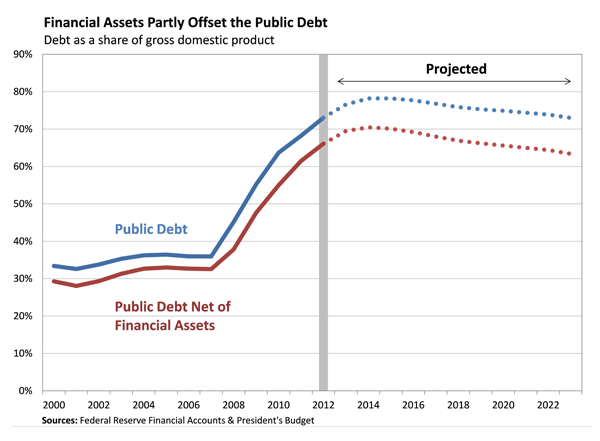When policy folks talk about America’s federal borrowing, their go-to measures are the public debt, currently $12 trillion, and its ratio to gross domestic product, which is approaching 75 percent. Those figures represent the debt that Treasury has sold into public capital markets, pays interest on, and will one day roll over or repay.
These debt measures are important, but they paint an incomplete picture of America’s fiscal health. They don’t account for the current level of interest rates, for example, or for the trajectory of future revenues and spending. A third limitation, the focus of this post, is that the public debt doesn’t give Treasury any credit for the many financial assets it owns.
As we noted last week, Uncle Sam has been borrowing not only to finance deficits but also to make student loans, build up cash, and buy other financial assets. That portfolio now stands at $1.1 trillion, equivalent to almost one-tenth of the public debt.
Those assets have real value. They pay interest and dividends and could be sold if Treasury ever cared to. In fact, Treasury has sold many financial assets in recent years, including mortgage-backed securities and equity stakes in TARP-backed companies, even as it expanded its portfolio of student loans.

One way to take account of these holdings is to subtract their value from the outstanding debt. The rationale is straightforward. If Ann and Bob each owe $30,000 in student loans and have no other debts, they both have the same gross debt. But that doesn’t mean their financial situations are the same. If Ann has $10,000 in the bank and Bob has only $5,000, then Ann is in a stronger position. Her net debt is $20,000, while Bob’s is $25,000.
The same logic applies to the federal government: $12 trillion in debt is easier to bear if the government has some offsetting financial assets than if it has none. That’s why both the Office of Management and Budget and the Congressional Budget Office regularly report the public debt net of financial assets. The net debt isn’t a perfect measure; many assets are harder to value than Ann and Bob’s bank accounts, and official valuations may not fully reflect their risk. Nonetheless, as CBO has said, the net public debt provides “a more comprehensive picture of the government’s financial condition and its overall impact on credit markets” than does the gross public debt.
The net debt is now a bit less than $11 trillion or about 68 percent of GDP. That’s more than $1 trillion less than the usual, gross measure of public debt, or about 7 percent of GDP. That difference was only 3 percent of GDP as recently as 2006. Under President Obama’s budget, it would expand to almost 10 percent by 2023, with financial assets growing twice as fast as the public debt.
Financial assets are thus playing a bigger role in America’s debt story. Accumulating deficits remain the prime driver of the debt. But the expansion of Uncle Sam’s investment portfolio means the growing public debt overstates America’s debt burden.